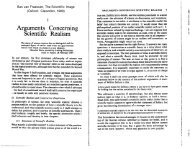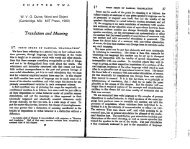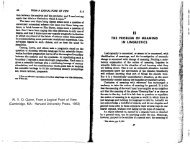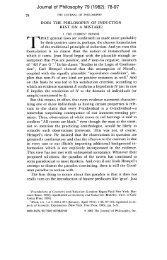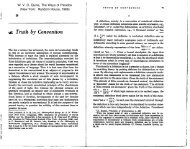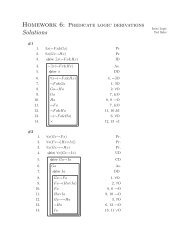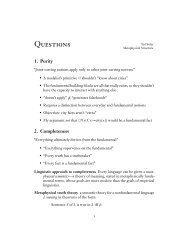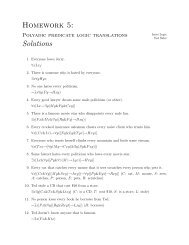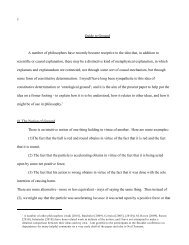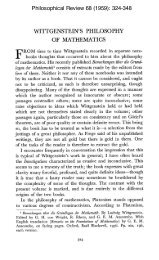Black - against quidditism.pdf - Ted Sider
Black - against quidditism.pdf - Ted Sider
Black - against quidditism.pdf - Ted Sider
Create successful ePaper yourself
Turn your PDF publications into a flip-book with our unique Google optimized e-Paper software.
Downloaded By: [New York University] At: 21:44 25 May 2010<br />
Robert <strong>Black</strong> 101<br />
there as a primitive. But I suspect that logico-mathematical necessity has to be in there as<br />
a primitive for David Lewis as well. Certainly the necessary truth of mathematical truths<br />
can't consist in their being true at every possible world, for pure mathematical objects<br />
such as pure sets or numbers don't seem to exist at worlds at all, and anyway for Lewis<br />
mathematics can be applied across worlds--e.g, any set of n worlds has 2 n subsets. Do I<br />
need more than primitive logico-mathematical modality, however? Let us go back to my<br />
claim at the beginning:<br />
3many W (W is a way & ~ the world is in w).<br />
The quantification here is over abstract mathematical entities. But what about the<br />
diamond? Do I need a further primitive modal notion to go from the existence of an<br />
abstract structure to the claim that the world could have exemplified it? Or is it enough for<br />
me simply to say that there are structures similar to the structure of the real world in some<br />
ways, but differing from it in others, and have I thereby said how the world 'could have<br />
been'? If the answer to this question is 'yes' (and I'll hazard that until presented with a<br />
convincing counterargument) then the abstract modal realist can claim a reduction of<br />
metaphysical necessity to logico-mathematical necessity, which I think is all, if not more<br />
than, anyone has a right to ask for.<br />
One further related problem deserves to be touched on. Among the infinity of<br />
mathematical structures, only one (or more exactly, one together with all its substructures)<br />
is exemplified in the real world. In what does this exemplification consist? Lewis raises<br />
this problem in his discussion of 'pictorial ersatzism' [10, pp. 171~], and although he<br />
classifies 'mathematical ersatzism' along with 'linguistic ersatzism', it would not surprise<br />
me if he were to classify my version as 'pictorial'. And Lewis might want to include my<br />
view among those he caricatures as belief in a large number of pictures, one of which has<br />
the additional magical ingredient 'vim' which makes it concrete rather than abstract.<br />
'Why', he asks, 'should we think we are part of the one with vim? How could we tell and<br />
why should we care?' [10, p. 173] To this I reply that my mathematical structures are not<br />
pictures, and they are not entities of some special kind invented for this version of modal<br />
realism, they are the familiar abstract entities dealt with by mathematics. Back in t973<br />
Lewis wrote 'I cannot believe (though I do not know why not) that our own world is a<br />
purely mathematical entity' [8, p. 90]. Well, neither can I.<br />
VI. 20<br />
If one abandons <strong>quidditism</strong>, what becomes of the thesis of Humean supervenience? It can<br />
certainly still be stated, as the thesis that the laws of nature supervene on the pattern of<br />
instantiation of qualities in spacetime. For this we need only a primitive intramundane<br />
identification of qualities--prior to consideration of what the laws are, it has to be<br />
determinate whether or not the same quality is manifested at any two given locations. Nor<br />
is there any difficulty in stating the supervenience claim in terms of possible worlds,<br />
20 This section expands on some points made in my [2].



